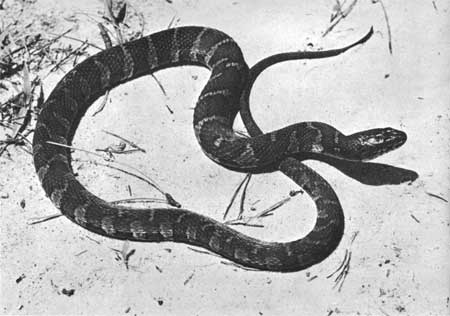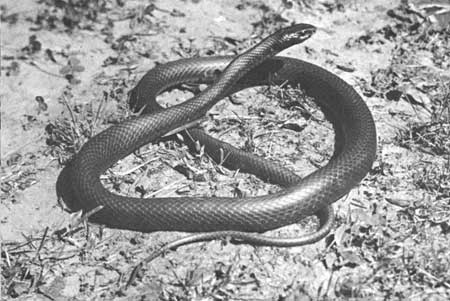|
GREAT SMOKY MOUNTAINS National Park |
 |
Snakes
Only two of the 23 snakes in Great Smoky Mountains National Park have venomous properties: the timber rattlesnake, which may range to 6,000 feet in places where the original forest has been disturbed, and the copperhead of the low and middle altitudes. In the Smokies, rattlesnakes rarely exceed a length of 4 feet, although reports of specimens more than 5 feet in length have been received. Chipmunks, red squirrels, gray squirrels, cottontails, and mice have been found in the stomachs of these snakes.
 The common water snake is well named. It is found in all the lower altitude streams, where it preys mostly upon fishes and frogs. Courtesy, Isabelle Hunt Conant. |
Hikers may cover hundreds of miles of park trails and fail to encounter a single rattlesnake, yet this species can hardly be regarded as scarce or rare. If you should encounter a rattlesnake while hiking in the park, the chances are it will attempt to get out of your way. If it should hold its ground, usually coiled and "buzzing," you can readily cause it to become more reasonable by the use of a fairly long stick. These heavy-bodied, slow-moving serpents are not aggressive. Danger from snakebite is greatest if you leave the trail in a region where there are rocky outcrops. In that case, be on the alert and look where you place your feet or your hands.
It is also important to remember that these two kinds of poisonous snakes may be active both day and night during the warmest part of the summer, and hikers should use flashlights or lanterns if walking about after dark.
Copperheads, although they do not occur as high in the mountains as rattlesnakes, often are found in the same kind of situations, and the two species are known to hibernate together. A smaller snake than the rattler, the copperhead may be identified quite readily by the hourglass pattern repeated along the length of its body. Copperheads are more secretive than rattlesnakes; a favorite haunt is in the immediate vicinity of an old sawdust pile.
 Rocky woodlands and old fields are favorite haunts of the black racer. Courtesy, Roger Conant. |
The largest of the 21 nonpoisonous snakes in the park include the pilot black snake, black racer, pine snake, common king snake, and corn snake. Of that number, the latter three are among our most handsomely marked serpents. Our smallest snakes include the worm snake, ground snake, DeKay's snake, red-bellied snake, crowned snake, and ring-necked snake. The rarest snakes in the park include the mole snake, scarlet snake, black king snake, scarlet king snake, queen snake, and the crowned snake. Still to be mentioned, in order to complete the list of Great Smoky Mountains National Park snakes, is the eastern hognose snake, eastern milk snake, rough green snake, common water snake, and common garter snake—the last two being, in all probability, the most abundant species in the area.

|

|
|
|
|
Last Modified: Sat, Nov 4 2006 10:00:00 pm PST |


